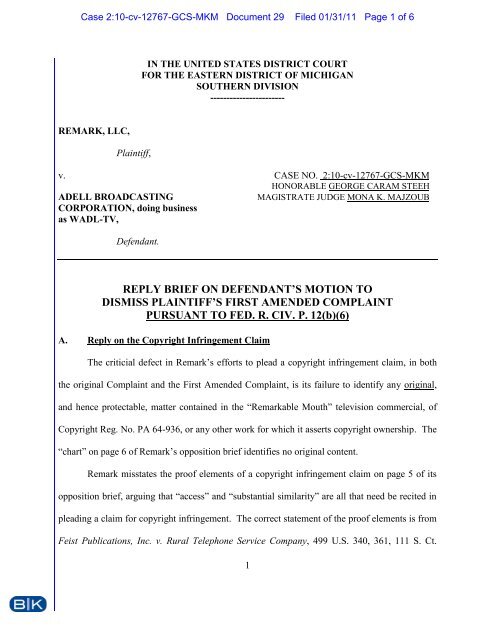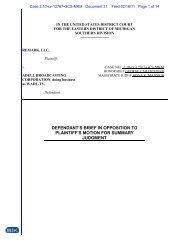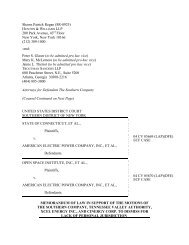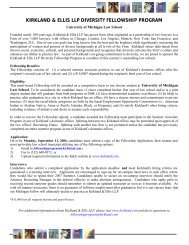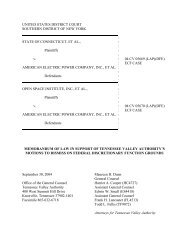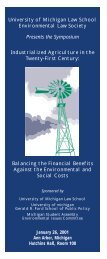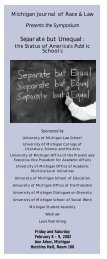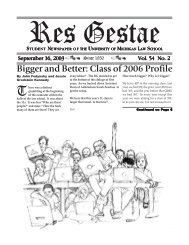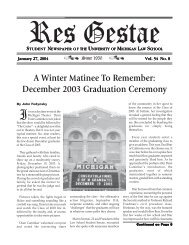REPLY BRIEF ON DEFENDANT'S MOTION TO DISMISS ...
REPLY BRIEF ON DEFENDANT'S MOTION TO DISMISS ...
REPLY BRIEF ON DEFENDANT'S MOTION TO DISMISS ...
You also want an ePaper? Increase the reach of your titles
YUMPU automatically turns print PDFs into web optimized ePapers that Google loves.
Case 2:10-cv-12767-GCS-MKM Document 29 Filed 01/31/11 Page 1 of 6<br />
IN THE UNITED STATES DISTRICT COURT<br />
FOR THE EASTERN DISTRICT OF MICHIGAN<br />
SOUTHERN DIVISI<strong>ON</strong><br />
-----------------------<br />
REMARK, LLC,<br />
Plaintiff,<br />
v. CASE NO. 2:10-cv-12767-GCS-MKM<br />
H<strong>ON</strong>ORABLE GEORGE CARAM STEEH<br />
ADELL BROADCASTING<br />
MAGISTRATE JUDGE M<strong>ON</strong>A K. MAJZOUB<br />
CORPORATI<strong>ON</strong>, doing business<br />
as WADL-TV,<br />
Defendant.<br />
<strong>REPLY</strong> <strong>BRIEF</strong> <strong>ON</strong> DEFENDANT’S MOTI<strong>ON</strong> <strong>TO</strong><br />
<strong>DISMISS</strong> PLAINTIFF’S FIRST AMENDED COMPLAINT<br />
PURSUANT <strong>TO</strong> FED. R. CIV. P. 12(b)(6)<br />
A. Reply on the Copyright Infringement Claim<br />
The criticial defect in Remark‟s efforts to plead a copyright infringement claim, in both<br />
the original Complaint and the First Amended Complaint, is its failure to identify any original,<br />
and hence protectable, matter contained in the “Remarkable Mouth” television commercial, of<br />
Copyright Reg. No. PA 64-936, or any other work for which it asserts copyright ownership. The<br />
“chart” on page 6 of Remark‟s opposition brief identifies no original content.<br />
Remark misstates the proof elements of a copyright infringement claim on page 5 of its<br />
opposition brief, arguing that “access” and “substantial similarity” are all that need be recited in<br />
pleading a claim for copyright infringement. The correct statement of the proof elements is from<br />
Feist Publications, Inc. v. Rural Telephone Service Company, 499 U.S. 340, 361, 111 S. Ct.<br />
1
Case 2:10-cv-12767-GCS-MKM Document 29 Filed 01/31/11 Page 2 of 6<br />
1282, 1296 (1991): ATo establish infringement, two elements must be proven: (1) ownership of<br />
a valid copyright and (2) copying of constituent elements of the work that are original.@<br />
(Boldface added.) The Feist Court emphasized that only original content is protectable: “As we<br />
have explained, originality is a constitutionally mandated prerequisite for copyright protection.”<br />
499 U.S. at 351. The principal Sixth Circuit case on proof of copyright infringement, Kohus v.<br />
Mariol, 328 F.3d 848, 853 (6 th Cir. 2003), follows the Feist rule on originality: “Not all<br />
„copying‟ is actionable, however: it is a constitutional requirement that a plaintiff bringing an<br />
infringement claim must prove „copying of constituent elements of the work that are original.‟<br />
Feist Publ'ns, Inc. v. Rural Tel. Serv. Co., 499 U.S. 340, 361, 111 S.Ct. 1282, 113 L.Ed.2d 358<br />
(1991) (emphasis added).” Under the Sixth Circuit‟s test for infringement, the “substantial<br />
similarity” analysis does not compare the accused work and the copyrighted work in their<br />
entireties; rather, only the “protectable elements” of the copyrighted work are compared to the<br />
accused work. Kohus, 328 F.3d at 855.<br />
Remark does not identify any original content of any work in its pleading; only some<br />
“common expressive and distinctive elements” distilled from a cloud of unregistered works. See<br />
FAC 8 and 9. Remark then purports to compare “expressive elements,” not original elements,<br />
in its multitude of unregistered works with Adell Broadcasting‟s accused commercials. By using<br />
this erroneous legal standard, Remark fails to plead a claim upon which relief can be granted.<br />
On pages 7-9 of its opposition brief, Remark argues that the Supreme Court in Reed<br />
Elsevier, Inc. v. Muchnick, 130 S. Ct. 1237 (2010) “rejected” the rule that only the new matter in<br />
a derivative work is protectable. Remark seriously misstates the holding of Reed Elsevier; the<br />
Supreme Court made no such rejection. The “rule” is statutory, 17 U.S.C. §103(b) (“The<br />
2
Case 2:10-cv-12767-GCS-MKM Document 29 Filed 01/31/11 Page 3 of 6<br />
copyright in a compilation or derivative work extends only to the material contributed by the<br />
author of such work, as distinguished from the preexisting material employed in the work, and<br />
does not imply any exclusive right in the preexisting material.”). Reed Elsevier clarified only<br />
that the registration requirement of 17 U.S.C. §411(a) as a prerequisite to a copyright<br />
infringement suit is more aptly described as “a precondition to filing a claim,” (130 S.Ct. at<br />
1241), or “claim-processing requirement,” (130 S.Ct. at 1244), not jurisdictional. Reed Elsevier<br />
comports with the Supreme Court‟s 2006 clarification of this point of law in Arbaugh v. Y & H<br />
Corp., 546 U.S. 500, 126 S.Ct. 1235, 163 L.Ed.2d 1097 (2006).<br />
Lastly, Remark faults Adell Broadcasting for stating the rule that pre-1989 publication of<br />
a work without notice may cause the work to enter the public domain. The rule is well-known<br />
and was re-stated by the Second Circuit in Martha Graham School And Dance Foundation, Inc.<br />
v. Martha Graham Center Of Contemporary Dance, Inc., 380 F.3d 624, 633, n. 14 (2d Cir.<br />
2004). Remark fails to plead its pre-1989 works were published with any copyright notice in<br />
conformity with this rule, a pre-1989 statutory condition for copyright protection.<br />
B. Reply On The Lanham Act §43(a) Claim<br />
Remark attacks the Sixth Circuit‟s 2001 decision in Murray Hill Publications, Inc. v.<br />
ABC Communications, Inc., 264 F.3d 622, 634-35 (6 th Cir. 2001), as “abrogated” by Reed<br />
Elsevier. Remark is wrong. The Murray Hill holding was validated by the Supreme Court in<br />
2003 in Dastar Corp. v. Twentieth Century Fox Film Corp., 539 U.S. 23, 123 S.Ct. 2041 (2003).<br />
Dastar called the same type of Lanham Act §43(a) false advertising claim advanced here by<br />
Remark “a species of mutant copyright law.” 539 U.S. at 35. Dastar bars these claims unless<br />
they are based on “tangible goods”:<br />
3
Case 2:10-cv-12767-GCS-MKM Document 29 Filed 01/31/11 Page 4 of 6<br />
In sum, reading the phrase "origin of goods" in the Lanham Act in accordance<br />
with the Act's common-law foundations (which were not designed to protect<br />
originality or creativity), and in light of the copyright and patent laws (which<br />
were), we conclude that the phrase refers to the producer of the tangible goods<br />
that are offered for sale, and not to the author of any idea, concept, or<br />
communication embodied in those goods. Cf. 17 U. S. C. § 202 (distinguishing<br />
between a copyrighted work and "any material object in which the work is<br />
embodied"). To hold otherwise would be akin to finding that § 43(a) created a<br />
species of perpetual patent and copyright, which Congress may not do. See Eldred<br />
v. Ashcroft, 537 U. S. 186, 208 (2003). (Boldface added.)<br />
Remark‟s argument on page 11 of its opposition brief that this rule was abrogated by<br />
Reed Eslevier in 2010, is baseless. The existence of “tangible goods” is a statutory predicate for<br />
a Lanham Act §43(a) false advertising claim. See, e.g., Johnson v. Jones, 149 F.3d 494, 503 (6 th<br />
Cir. 1998), where defendant Tosch literally removed plaintiff Johnson‟s name and seal from<br />
architectural drawings and replaced them with his own.<br />
Remark fails to meet the “tangible goods” requirement of Dastar, and thereby fails to<br />
state a Lanham Act §43(a) false advertising claim.<br />
C. Reply On The Breach Of Contract Claim<br />
Remark alleges in 57 of the First Amended Complaint that:<br />
57. The terms of the oral agreement were placed into a document entitled<br />
“Settlement Agreement and Mutual Release (“Settlement Agreement”), a copy of<br />
which is attached as Exhibit H.<br />
The preamble of the “Settlement Agreement” of Exhibit H to the First Amended<br />
Complaint states, in relevant part:<br />
This Settlement Agreement and Mutual Release (“Agreement”) ... shall become<br />
effective as of the date the parties sign the Agreement. (Boldface added.)<br />
The “merger” clause of paragraph 12 of Exhibit H states, in relevant part:<br />
12. This Agreement constitutes and contains the entire agreement and<br />
understanding concerning the subject matter hereof between the Parties, and<br />
4
Case 2:10-cv-12767-GCS-MKM Document 29 Filed 01/31/11 Page 5 of 6<br />
supersedes and replaces all prior negotiations, proposed amendments or<br />
agreements, written or oral. (Boldface added.)<br />
These provisions make it clear that (A) the parties manifested an intent not to be bound<br />
until execution of a written or formal contract, and (B) preceding communications would not be<br />
operative as an offer or acceptance. Accordingly, under Michigan contract law, there is no<br />
contract. Angelo DiPonio Equipment Co. v. State of Michigan, 107 Mich. App. 756, 761, 309<br />
N.W.2d 566, 568 (1981):<br />
The trial court further found that since defendants manifested an intent not<br />
to be bound until the execution of a written or formal contract, no valid and<br />
enforceable obligation arose. We agree.<br />
In Michigan Broadcasting Co. v. Shawd, 352 Mich. 453, 90 N.W.2d 451<br />
(1958), the Court held that if the parties indicated that the expected or proposed<br />
contract was to be the exclusive, operative consummation of the negotiations, the<br />
preceding communications would not be operative as an offer or acceptance. See<br />
also 17 Am.Jur.2d, Contracts, s 28, p. 363, 1 Williston on Contracts (3d ed.), s 28,<br />
p. 66, 1 Corbin on Contracts, s 30, pp. 97-112.<br />
Remark‟s breach of contract claim fails as a matter of law on the admitted facts of Count<br />
III, namely that the parties intended only to be bound unless the contract was signed, and that all<br />
prior negotiations, proposed amendments or agreements, written or oral, were superseded.<br />
Respectfully submitted,<br />
BROOKS KUSHMAN P.C.<br />
Dated: January 31, 2011<br />
By: /s/ Robert C.J. Tuttle<br />
Mark A. Cantor (P32661)<br />
Robert C.J. Tuttle (P25222)<br />
1000 Town Center, 22 nd Floor<br />
Southfield, Michigan 48075-1238<br />
Tel: (248) 358-4400 / Fax: (248) 358-3351<br />
Email: mcantor@brookskushman.com<br />
rtuttle@brookskushman.com<br />
Attorneys for Defendant<br />
5
Case 2:10-cv-12767-GCS-MKM Document 29 Filed 01/31/11 Page 6 of 6<br />
CERTIFICATE OF ELECTR<strong>ON</strong>IC SERVICE<br />
I hereby certify that on January 31, 2011 I electronically filed the foregoing<br />
<strong>REPLY</strong> <strong>BRIEF</strong> <strong>ON</strong> DEFENDANT’S MOTI<strong>ON</strong> <strong>TO</strong> <strong>DISMISS</strong> PLAINTIFF’S FIRST<br />
AMENDED COMPLAINT PURSUANT <strong>TO</strong> FED. R. CIV. P. 12(b)(6) with the Clerk of the<br />
Court for the Eastern District of Michigan using the ECF System which will send notification to<br />
the registered participants of the ECF System as listed on the Court's Notice of Electronic Filing.<br />
I also certify that I have mailed by United States Postal Service the paper to the following nonparticipants<br />
in the ECF System: None.<br />
BROOKS KUSHMAN P.C.<br />
By: /s/ Robert C.J. Tuttle<br />
Mark A. Cantor (P32661)<br />
Robert C.J. Tuttle (P25222)<br />
1000 Town Center, 22 nd Floor<br />
Southfield, Michigan 48075-1238<br />
Tel: (248) 358-4400 / Fax: (248) 358-3351<br />
Email: mcantor@brookskushman.com<br />
rtuttle@brookskushman.com<br />
Attorneys for Defendant<br />
6


